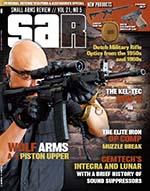The Kel-Tec RDB-S
By Oleg Volk
Available with 20-inch or 17.3-inch barrels, the latter picked to match the ATF-mandated minimum overall length of 26”; it’s a handy and reliable weapon.
5.56mm Kel-Tec RDB has been one of my favorite designs since long before the production versions shipped. It’s accurate, well balanced, completely ambidextrous and doesn’t kick much. Available with 20-inch or 17.3-inch barrels, the latter picked to match the ATF-mandated minimum overall length of 26”; it’s a handy and reliable weapon. Some faulted it for bottom ejection, a feature that no serious weapon–other than Vickers, Lewis, Bren, Browning 1919, MAG58, P90 and a few others–would have. With the empties dropping right under the shooter, long sleeves are recommended for prone position. The introduction of RDB-C in 5.56mm and 6.5mm Grendel took me entirely by surprise–RDB without a pistol grip–George Kellgren handed me a weapon that looked like something out of Star Wars and told me I could try it out. I assumed that the evolution of the short action RDB was complete at that point, only to be surprised again.
RDB-S, “S” standing for Survival model, is a development of RDB-S, also without a protruding pistol grip. The barrel is only 16.1 inches long, which puts the overall length of the rifle into NFA territory ... except that RDB-S comes with a variable length stock which extends far enough out to make the entire rifle longer than 26 inches when deployed. Starting out with a relatively short length of pull, RDB benefits from this lengthening when fired from sitting or prone positions. Compared to the pistol grip, the angled gripping surface of the C model permitted a much higher hold. With the hand effectively around the bore of the rifle, pointing became very natural. The thumb may me wrapped around the upper receiver for a more secure hold or held alongside the lower for a smoother trigger pull. The trigger is 4 pounds and feels much like a safe action pistol, which I like because if affords a surprise break. The decision to go gripless may have been motivated by the efficiency of backpack carry, as RDB-S is much smaller top to bottom than the pistol grip model. To that same end, it is equipped with folding front and rear sights that stow flat, even with the Picatinny rail and out of the way.
The Survival model inherits the slow firing and reloading cycle taking nearly 1/8 of a second, with bolt carrier motion very well dampened. With the ejection port behind the magazine, the bolt has quite a bit of travel before it strips the next round from the magazine, providing very reliable feeding. The overall weight is even less than the regular RDB, right at 5 pounds with the sights already installed. Besides the grip shape, RDB-S inherits the C model fenced push-button magazine release design. Magazine release buttons are on both sides, as are the 60 degree safety levers. The folding charging handle may be swapped from left to right in a few seconds without tools. The forend has a centrally located molded-in sling channel. The furniture is entirely interchangeable between the three RDB models, and forends and the lowers may be mixed and matched–but be careful of reducing the overall length below the arbitrary legal threshold. The RDB-S muzzle is threaded, but that portion is covered by the front sight base. It has no brake or flash hider, giving slightly more sight radius instead.
Since only two prototypes of RDB-S exist at this time, I have not fired them. My experience with other samples of this type is excellent. With the rapid twist rate, the guns shoot sub-MOA with 69 to 75gr bullets and almost as well with 62gr. Lighter bullets have more dispersion, but that’s of slight concern for action shooting. In a defensive carbine course, 55gr ammunition proved sufficiently accurate, certainly well ahead of every AR15 on the line. The sight radius is similar to the M4 carbine, adequate to 200+ yards. The ability to support the RDB very near the muzzle improves practical accuracy. The difference from the longer-barreled models should be incremental: the slightly stiffer barrel should give fractionally reduced mechanical dispersion, while slightly reduced muzzle velocity would increase wind drift just as minimally.
Internally, the rifle is very simple. Field-stripping requires removal of just two captive pins to get full access to all major components. The RDB-S long stroke gas system is adjustable, but the rifle can’t mount sound suppressors unless the front sight tower is removed first. Once the folding front sight is gone, a suppressor can go in its place, a reasonable trade if you prefer optics or can make do with a slightly shorter iron sight radius.
Shipping with a flush-fitting 10-round magazine, RDB-C also accepts all other AR magazines, including drums. X Products 50-rounder and Magpul D60 are small enough for comfort should a higher volume of fire be required. With the overall length of just 24.5 inches collapsed and 26.1 inches deployed, this rifle can be carried discreetly under a backpack or under a coat. With the terrific practical accuracy, light weight and ambidextrous fit, it can be a good family weapon to take when bugging out of the path of danger.
This article first appeared in Small Arms Review V21N5 (June 2017) |
| SUBSCRIBER COMMENT AREA |
Comments have not been generated for this article.






